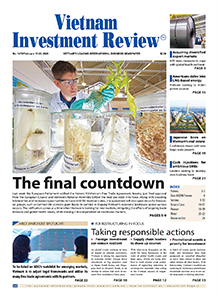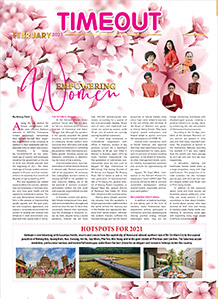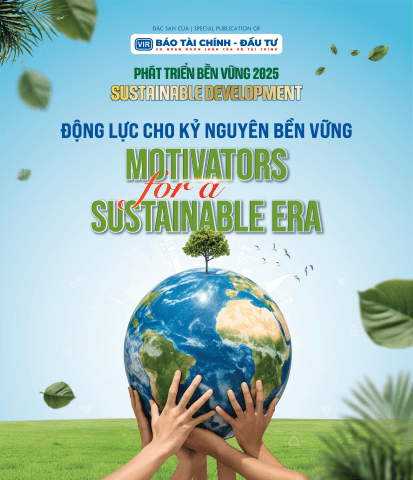New impetus for the tourism industry
The first international conference on rural tourism organised by the United Nations Tourism in the central province of Quang Nam in December 2024 updated policies on sustainable rural development worldwide.
Ho An Phong, Deputy Minister of Culture, Sports, and Tourism, said that Vietnam is an agricultural country with more than 70 per cent of the population living in rural areas. Therefore, the countryside is also home to unique cultural and natural heritages, which can be built into attractive products for international visitors.
“International guests come to Vietnam not only to experience luxury hotels but also to explore peaceful villages,” Phong said. “Rural tourism has therefore contributed to transforming livelihoods and increasing incomes. It supports the maintenance of traditional occupations, the development of valuable local products, and the attraction of investment in the agricultural and rural sectors,” he added.
 |
| New impetus for the tourism industry |
Over the years, rural tourism has made an important contribution to changing the face of Vietnam. Moc Chau district in the northern mountainous province of Son La boasts more than 2,000 hectares of tea, more than 3,000ha of vegetables, over 10,000ha of fruit trees. For many years, it has strongly developed farm-stay models, becoming an ideal place for people to experience ecological agriculture in the northern region.
In Quang Nam, agricultural and rural tourism began to take shape in the 2000s and has evolved strongly since 2013 with 125 related spots listed. According to estimates from its Department of Tourism, out of every one million visitors coming to Quang Nam, 30 per cent choose to experience agro-rural products. Some notable destinations include Thanh Ha pottery village, Tra Que vegetable village, Bay Mau coconut forest, Kim Bong carpentry village, and Co Tu village. In November, Tra Que was recognised by the UN Tourism as the best tourist village of the year.
Two other villages have been recognised as best for guests by the UN Tourism. Thai Hai Village in Thai Nguyen province was named in 2022 for its unique feature of preserving the traditional culture of the Tay ethnic group in daily life, while Tan Hoa in Quang Binh province was recognised the following year for its unique feature of exploring and experiencing the lives of people in flood-prone areas in floating houses.
To implement the Vietnam tourism development strategy to 2030 and the nation’s sustainable agriculture and rural strategy to 2030, Vietnam approved new rural construction that aimed to encourage the potential of agriculture, craft villages, and the ecological environment of rural areas, contributing to transformation towards integration and inclusiveness.
Nguyen Trung Khanh, director of the Vietnam National Authority of Tourism, said that the system of rural destinations in Vietnam has developed across the country, with many enticing high-quality products.
“The north currently has many agricultural tours exploiting traditional rice planting and cultivation activities, handicrafts, and livestock farms. Around the suburbs of Hanoi, there are currently 11 ecological agricultural farms operating under the model of education and experiential tourism, and many areas with potential and advantages for building agricultural and rural tourism,” Khanh said.
In the central and Central Highlands areas, there are also products that demonstrate agricultural diversity, such as tours to visit ethnic minority villages. Meanwhile, the Mekong Delta region with its characteristics of rivers and garden houses also has potential to exploit agricultural tourism.
“Vietnam currently has 36 community products and services recognised as 3-4 stars, 365 rural destinations, and over 70 routes exploiting rural tourism, attracting up to 15 per cent of tourism workers. The main customers are school visitors, families travelling on weekends, young groups from urban areas, and foreign guests,” Khanh added.
According to the World Tourism Organisation, the number of people partaking in agricultural and rural tourism holds 10 per cent, with revenue of about $30 billion per year.
In Vietnam, agricultural and rural tourism also brings many opportunities for strong growth and is expected to help Vietnam draw in an additional 22-23 million international visitors in 2025.
| Zoritsa Urosevic, deputy secretary-general, United Nations Tourism
We are delighted that in recent years Vietnam has strongly implemented commitments to empower rural communities, with a significant part of this being through tourism activities. Tra Que vegetable village in Quang Nam, Tan Hoa village in Quang Binh, and Thai Hai ecotourism area in Thai Nguyen are excellent examples of Vietnam’s efforts in improving people’s lives, preserving the beauty of natural ecosystems as well as the indigenous cultural values. I believe that Vietnam as a whole, and Quang Nam in particular, have many other outstanding villages that meet the criteria to join UN Tourism’s best village network in the future. The industry has the potential to create a large number of job opportunities for rural labour. Tourism also provides access to knowledge, enhances self-worth, and improves the lives of vulnerable groups in this area. We are committed to being a steadfast partner in supporting Vietnam’s rural tourism development with a sustainable vision. Through our observations, we have noticed that Vietnam’s rural areas boast a rich agricultural product system, including many precious specialities. Vietnam needs technological solutions to bring these exceptional products to the market, both directly and online. This way, the market reach for these products will be greatly expanded. Currently, UN Tourism has a small-scale funding scheme to promote rural tourism by supporting villages or entities engaged in rural tourism in privately owned areas. This provides assistance in marketing capabilities, positioning for sustainable development, circular economy adaptation, and other aspects to align with global trends, if needed. Ha Van Sieu, deputy director general Vietnam National Authority of Tourism
Like many developing countries, rural areas in Vietnam also face numerous challenges. The majority of agritourism and rural tourism models in remote areas of Vietnam are small-scale, fragmented, lack professionalism, face difficulties in transportation infrastructure, and have limited investment and personnel. Vietnam’s rural policies need to focus on honouring and preserving local culture, providing attractiveness, distinctiveness, and increasing competitiveness for destinations. Policies should also aim to help local communities protect traditional culture, preserve the environment, create unique products with their own branding to create responsible tourism, while still maintaining their identity. In the coming time, we will focus on connectivity and collaboration among relevant stakeholders, as this is an essential issue. Priorities include infrastructure connectivity, market promotion, promotion of tour routes, and public-private partnerships, especially linking rural destinations into value chains. Policies will also aim to enhance awareness of tourism development and skills. We want to place human beings at the centre, with local communities as the main driving force to preserve values, while controlling destinations to harmonise interests and ensure benefits for residents. Andreas Paul Kung, director, Tui Blue Nam Hoi An
The primary concern in rural tourism development is to preserve the indigenous features, unique cultural values of the locality, the village, and the way of life of the local people there. We do not need to make too many changes because the most attractive factor of a product, a destination, is authenticity with core primitive values, providing attraction for visitors. I believe Quang Nam is doing well in this aspect and should strive to further enhance it. Although I do not have an overall view of your villages, in the rural areas, the villages around Hoi An where I had the opportunity to observe or experience, the most impressive thing is still the authentic values. Of course, to elevate rural tourism, preserving cultural values, nature, and community identity is important, but it is not enough. We need to further enhance the collaboration between the government and businesses. In this partnership, the role of the government is crucial, and businesses play a key role in the success of rural tourism. Although I have not been in Vietnam for long, I have felt the sharing and companionship from government agencies, especially in Quang Nam, which has contributed to the success of various rural tourism models, with Tra Que vegetable village being a wonderful example. With this foundation, the expansion of rural tourism in Quang Nam in the future is sure to be more diverse and widespread. |
What the stars mean:
★ Poor ★ ★ Promising ★★★ Good ★★★★ Very good ★★★★★ Exceptional
Related Contents
Latest News
More News
- Scandinavian Airlines and Vietnam Airlines broaden agreement with new routes (November 25, 2025 | 17:04)
- Halong Cruise Port welcomes over 3,100 international visitors (November 12, 2025 | 18:06)
- Vietnam.travel climbs to second place in Southeast Asia website rankings (November 12, 2025 | 18:01)
- Cat Ba named among Southeast Asia’s top island adventures (November 11, 2025 | 18:09)
- Vietnam Airlines' Lotusmiles partners with ALL Accor to unlock more rewarding journeys (November 08, 2025 | 10:25)
- International arrivals to Vietnam hit record high in October (November 06, 2025 | 18:22)
- Etihad launches flights from Hanoi to Abu Dhabi (November 04, 2025 | 15:14)
- Oxford deepens Vietnam partnerships in healthcare, education, aviation (November 04, 2025 | 11:45)
- Vietjet lifts aviation training to new heights with Airways Aviation (October 22, 2025 | 15:06)
- UOB Vietnam promotes ecotourism in Quang Tri's 'Kingdom of Caves' (October 21, 2025 | 16:14)




 Tag:
Tag:



















 Mobile Version
Mobile Version